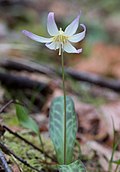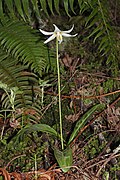Loading AI tools
Genus of flowering plants From Wikipedia, the free encyclopedia
Erythronium, the fawn lily, trout lily, dog's-tooth violet or adder's tongue, is a genus of Eurasian and North American plants in the lily family,[2][3][4][5][6] most closely related to tulips.[7] The name Erythronium derives from Ancient Greek ἐρυθρός (eruthrós) "red" in Greek, referring to the red flowers of E. dens-canis.[7] Of all the established species, most live in North America; only six species are found in Europe and Asia.
| Erythronium | |
|---|---|
 | |
| Erythronium dens-canis | |
| Scientific classification | |
| Kingdom: | Plantae |
| Clade: | Tracheophytes |
| Clade: | Angiosperms |
| Clade: | Monocots |
| Order: | Liliales |
| Family: | Liliaceae |
| Subfamily: | Lilioideae |
| Tribe: | Lilieae |
| Genus: | Erythronium L. |
| Type species | |
| Erythronium dens-canis | |
| Synonyms[1] | |
| |
Erythronium includes about 20–30 species of hardy spring-flowering perennial plants with long, tooth-like bulbs. Slender stems carry pendent flowers with recurved tepals in shades of cream, yellow, pink and mauve. Species are native to forests and meadows in temperate regions of the Northern Hemisphere.[1][8][9]
| Image | Species | Common name | Distribution |
|---|---|---|---|
 | Erythronium albidum Nutt. | small white fawn-lily, white fawn-lily, white trout-lily, tooth-lily | Ontario, east-central United States (MN to CT south to TX, AL) |
 | Erythronium americanum Ker-Gawl. | trout-lily, yellow trout-lily, yellow adder's-tongue, yellow dogtooth violet | Eastern Canada (Ontario to Labrador), Eastern United States (ME to GA, West to Mississippi River) |
 | Erythronium californicum Purdy | California fawn-lily | Northern California |
 | Erythronium caucasicum Woronow | Caucasian dog's tooth violet | Caucasus, Iran |
 | Erythronium citrinum S. Wats. | cream fawn-lily | Oregon, Northern California |
 | Erythronium dens-canis L. | dog's-tooth violet | Southern, Central Europe from Portugal to Ukraine |
| Erythronium elegans Hammond & Chambers | Coast Range fawn-lily | Oregon | |
 | Erythronium grandiflorum Pursh | dogtooth lily, glacier lily, yellow avalanche-lily, yellow fawn-lily | western Canada, western United States |
 | Erythronium helenae Applegate | Pacific fawn-lily | California (Sonoma, Napa, Lake Cos.) |
 | Erythronium hendersonii S. Wats. | Henderson's fawn-lily | Oregon, Northern California |
| Erythronium howellii S. Wats. | Howell's fawn-lily | Oregon, Northern California | |
| Erythronium idahoense H.St.John & G.N.Jones - | Idaho fawn-lily | Montana, Idaho, Washington state | |
 | Erythronium japonicum Decne. | katakuri | Japan, Korea, Russia (Kuril Islands, Sakhalin), China (Jilin, Liaoning) |
 | Erythronium klamathense Applegate | Klamath fawn-lily | Oregon, Northern California |
| Erythronium krylovii Stepanov | Tuvan trout-lily | Russia (Tuva, Krasnoyarsk) | |
 | Erythronium mesochoreum Knerr | midland fawn-lily, white fawn-lily | Central United States (TX to NE, IN) |
 | Erythronium montanum S. Wats. | avalanche lily, white avalanche-lily | BC, Washington state, Oregon |
 | Erythronium multiscapideum (Kellogg) A. Nels. & Kennedy | Sierra fawn-lily | California |
 | Erythronium oregonum Applegate | giant white fawn-lily | BC, Washington, California, Oregon |
| Erythronium pluriflorum Shevock, Bartel & G.A.Allen | manyflower fawn-lily | Madera Co in California | |
 | Erythronium propullans Gray | dwarf trout-lily | Minnesota |
 | Erythronium purpurascens S. Wats. | purple fawn-lily | California |
 | Erythronium pusaterii (Munz & J.T. Howell) Shevock, Bartel & G.A.Allen | Kaweah Lakes fawn-lily | Tulare Co in California |
| Erythronium quinaultense G.A.Allen | Olympic fawn-lily | Olympic Peninsula in Washington state | |
 | Erythronium revolutum Sm. | mahogany fawn-lily | BC, Washington state, Oregon, California |
 | Erythronium rostratum W.Wolf | yellow trout-lily | south-central United States |
 | Erythronium sajanense Stepanov & Stassova | Krasnoyarsk in Russia | |
 | Erythronium sibiricum (Fisch. & C.A.Mey.) Krylov | Siberian fawn-lily | Siberia, Kazakhstan, Xinjiang, Mongolia |
 | Erythronium sulevii (Rukšans) Stepanov | Altay Krai in Russia | |
 | Erythronium taylorii Shevock & G.A.Allen | Taylor's fawn-lily | Tuolumne Co California |
 | Erythronium tuolumnense Applegate | Tuolumne fawn-lily | Tuolumne Co in California |
 | Erythronium umbilicatum Parks & Hardin | dimpled trout-lily | southeastern United States (Florida to Kentucky, West Virginia, Maryland) |
Two species names were coined using the name Erythronium but have since been reclassified to other taxa.
Erythroniums are widely grown as ornamental plants, with numerous hybrids and cultivars having been selected for garden use. Popular cultivars include Erythronium 'Pagoda', E. 'Sundisc', E. 'Joanna', E. 'Kondo', E. 'Citronella', E. californicum 'White Beauty', and E. 'Rosalind'. Propagation is best by seed in autumn or by division of bulbs, depending on species. Some species propagate vegetatively. The plant is also great as a ground cover, as it will spread over several years.
Erythroniums are woodland plants and require rich soil, full of organic matter. Soil should be evenly moist and slightly acidic. They prefer shade or filtered sunlight.[10]
The following cultivars, of mixed ancestry, have won the Royal Horticultural Society's Award of Garden Merit:
The bulb is edible as a root vegetable, cooked or dried, and can be ground into flour. The leaves can also be cooked as a leaf vegetable. In Japan, Erythronium japonicum is called katakuri, and the bulb is processed to produce starch, which is used for food and other purposes.
Seamless Wikipedia browsing. On steroids.
Every time you click a link to Wikipedia, Wiktionary or Wikiquote in your browser's search results, it will show the modern Wikiwand interface.
Wikiwand extension is a five stars, simple, with minimum permission required to keep your browsing private, safe and transparent.